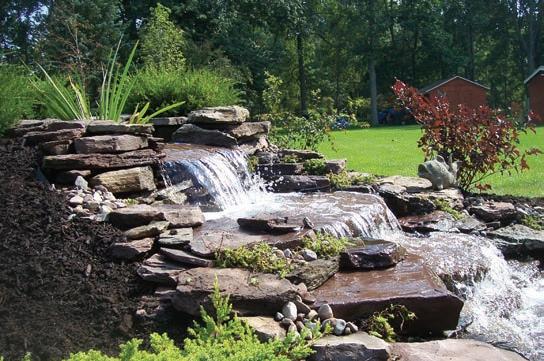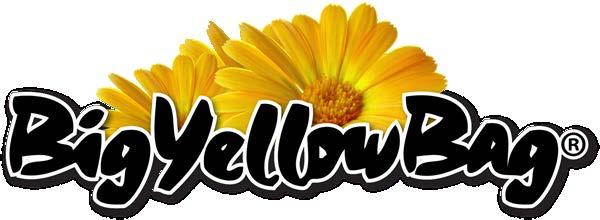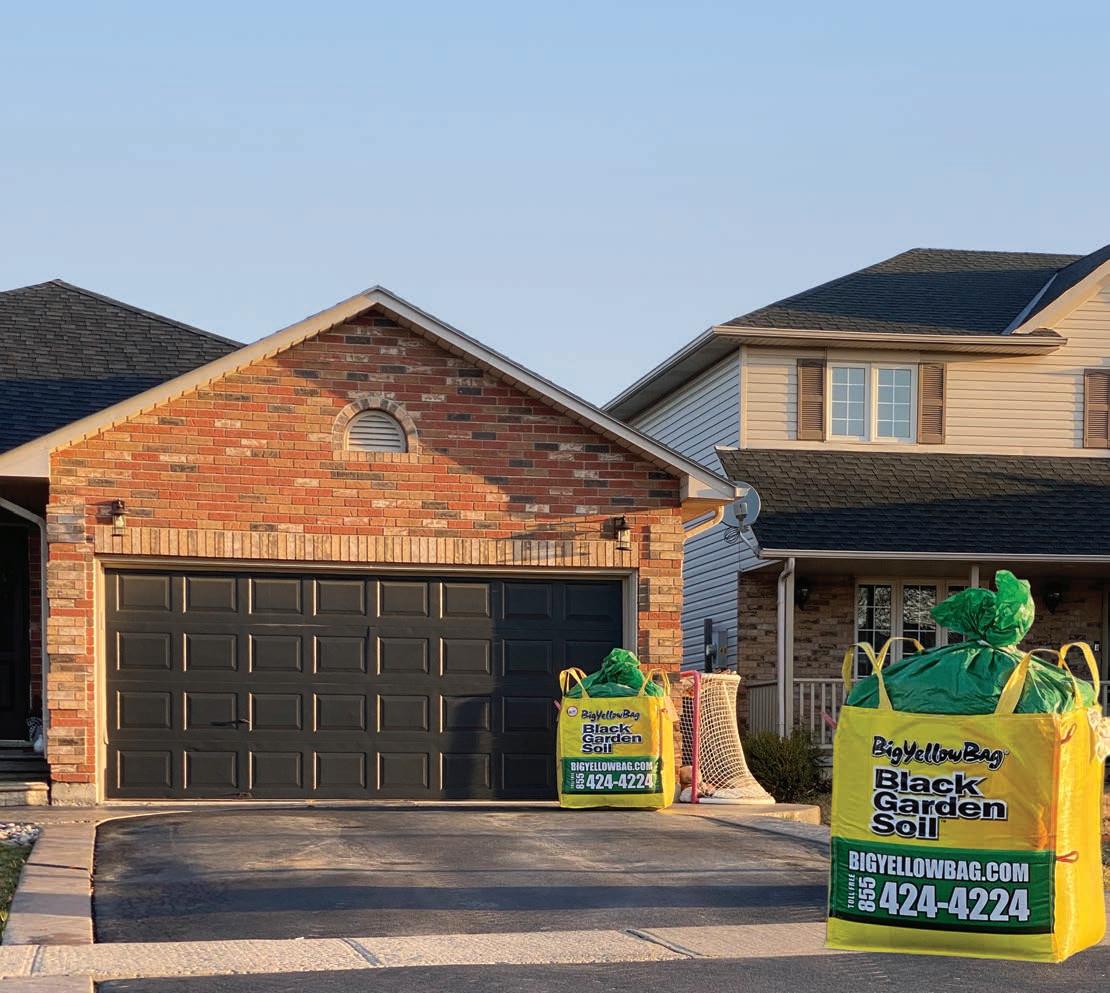
Public gardens
Beech tree diseases
DIY rain chain

FREE Volume Twenty-nine, Issue Four July-August 2024













Public gardens
Beech tree diseases
DIY rain chain

FREE Volume Twenty-nine, Issue Four July-August 2024











A customer recently said that you should never plant anything during a month without the letter ‘R’ in its name. What? You mean I’m done on April 30th?? Wow, how do you possibly adhere to that? We get the logic, sort of, but that would surely leave many plants out of the repertoire, like, we can’t imagine not planting in May, June, July, and yes, even August.
Our motto is, if you have a hose, you can plant it!
This brings us to our next summer point. If you bought it and planted it, the plan should include how you’re watering it. Watering is tricky. It sounds easy enough, but every plant has very individual needs, and when you throw in the weather and soil quality, things can get dicey pretty quick! However, here are a few general and straightforward rules that can help.
• Overhead watering, like sprinklers on a bed mixed with a different blend of plants, will not always provide optimum results. (So get the sprinklers on the lawn thing? All the same plants.)
• Overhead watering means a lot of wet foliage, which can lead to mildews and other issues that, while they may not kill your plant, can make it very unattractive, which is disappointing.
• Watering directly at the soil level is always the best method.
• Thorough, deep waterings done less frequently are always better than little bits of water every day.
• Recovering from brief wilt from dry soil is a much easier recovery for most plants than drowning, so erring on the drier side can often help.
• Please pay attention to your plants; they’re constantly furnishing you with info.
Are we giving up summer planting? Not on your life!! For one, there are not enough days of good weather to cut them short. There are too many plants and not enough hours in the day. There are too many spaces left to fill! If you are with us, we’ll see you soon.
To contact us, call the nursery at 585-637-4745 or email us at kkepler@rochester.rr.com.

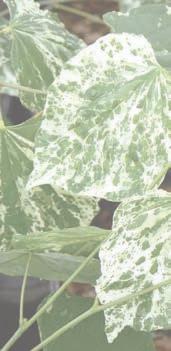



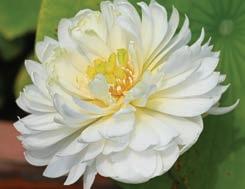

2pm for before single petal lotus close.
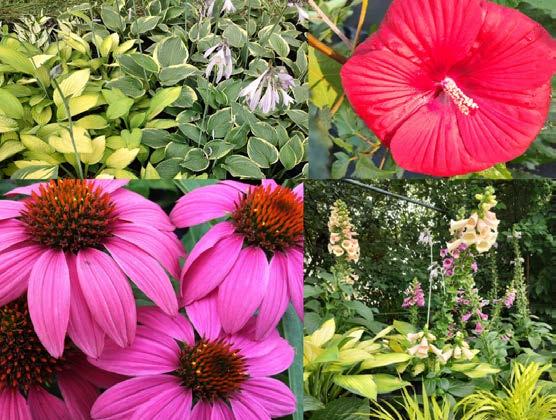
PUBLISHER/EDITOR: Jane F. Milliman
MANAGING EDITOR: Christine Green
GRAPHIC DESIGNER: Cathy Monrad
TECHNICAL EDITOR: Brian Eshenaur
CONTRIBUTING WRITERS:
MICHELLE SUTTON | LIZ MAGNANTI | JANET ALLEN ANU SCOFIELD | CHRISTINE GREEN | BETH MATTIMORE
1501 East Avenue, Suite 201, Rochester, NY 14610
585/733-8979
e-mail: info@upstategardenersjournal.com upstategardenersjournal.com
The Upstate Gardeners’ Journal is published six times a year. To subscribe, please send $20.00 to the above address. Magazines will be delivered via U.S. mail and/or email (in PDF format). We welcome letters, calls and email from our readers. Please tell us what you think!
We appreciate your patronage of our advertisers, who enable us to bring you this publication. All contents copyright 2024, Upstate Gardeners’ Journal.
On the cover: Pot marigold (Calendula officinalis) in Jasper, NY by Bonnie Guckin

SUBSCRIBE! Never miss another issue to our area’s guide to everything gardeners want to know! Get the UGJ delivered to your door six times a year for just $20.00. SAVE! Subscribe for 2 years for $38.00.
TO GIVE AS A GIFT, simply check the gift option and add your name. We’ll send a notice and start the subscription.
PREFER TO PAY WITH CREDIT CARD? Subscribe or renew by phone—585/733-8979—or on our website. upstategardenersjournal.com
Subscribe for: ❍ 1 year: $20.00 ❍ 2 years: $38.00 (6 issues) (12 issues) Send subscription to:
1501 East Ave, Ste 201 Rochester, NY 14610 585/733-8979
Hello, gardeners!
I was just reading the letter I wrote in our March/April issue. I mentioned how I view my garden as another room in my house that is closed all winter. Well, now that my garden is open, I am rarely in any other space in my home. My mornings, evenings, and weekends are filled with those chores we all must deal with—weeding, watering, reorganizing, pruning, etc. My friend and yoga teacher, Melissa Kleehammer (see page 6 for her tips on stretching for gardeners) recently asked me if I ever sit in my garden and enjoy it without working. Well, I almost never just spend time in my garden without doing something. Oh, I try, I really do. But even when I intend to sit with some coffee and take it all in, I end up setting down the cup and pulling weeds or filling the bird feeder or deadheading the petunias … you get it. But that doesn’t mean I don’t enjoy it. On the contrary, I adore my little garden, and every weed pulled or flower tended is a form of meditation and even love.
Here’s to the fun of gardening in high summer! Stay cool out there.


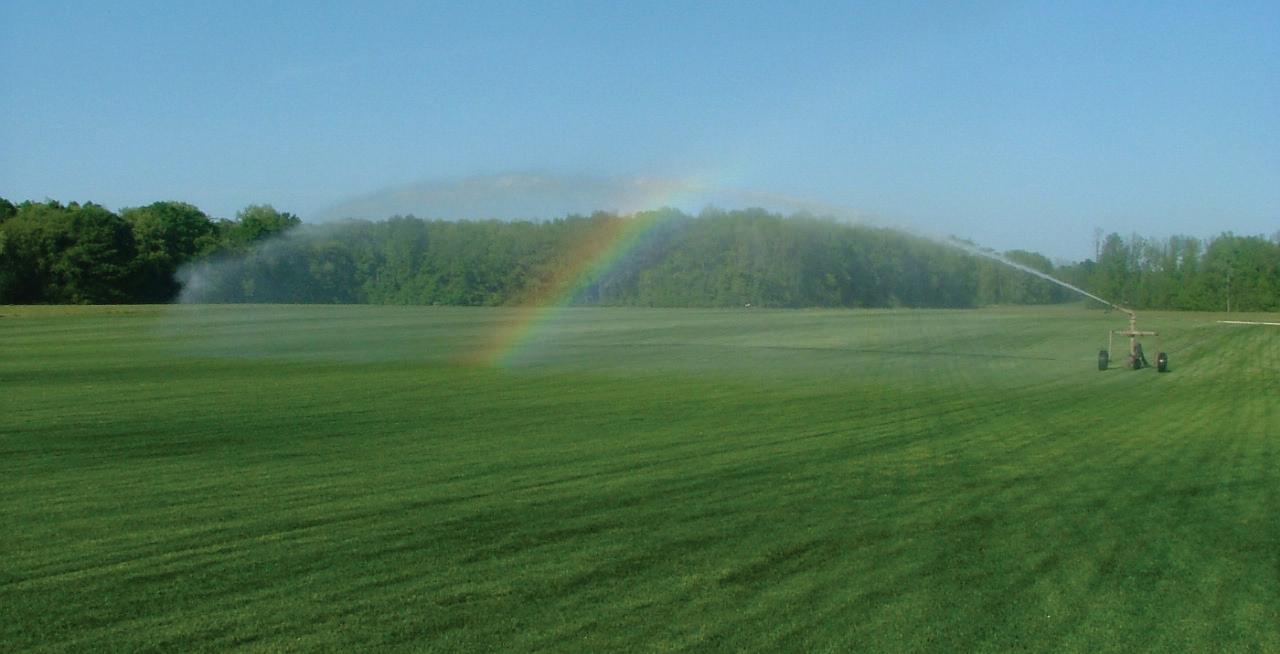

By Anu Scofield
One-hundred-and-fifty years ago, Canandaigua botanists began meeting in their homes to discuss and appreciate the native plant life around the Finger Lakes region. They read poetry, collected specimens for analysis, and went on field trips to explore neighboring biomes. In 2024, they are the second oldest botanical society in the US and are still going strong. They celebrated the group’s sesquicentennial anniversary the first weekend of June.
The group is now made up of gardeners, birders, people interested in the medicinal value of plants, and many others who share the joy of nature. Embarking on frequent trail walks led by knowledgeable members, they often make lists of wildflower species observed. Sometimes their walks are focused on specifics like ferns or fungi, but the conversations always go above and beyond the topic.
Working closely with the Finger Lakes Herbarium, pressings from early in the club’s history have been catalogued in the Finger Lakes Community College plant library. Samples collected as early as 1890 are preserved. Nearly all the unidentified plants have been accurately named and digitized to safeguard the information for generations to come.
This is just one of their conservation interests. Protection of native species is an essential component to their creed, which all starts with education. The vast base of knowledge held by the group makes for a community of plant-lovers always seeking to learn something.
Laura Ouimette, coordinator and member since 1999, says: “come along and learn one thing.” Although the amount of information may be overwhelming, there is no test, so anybody interested should attend for the “pure enhancement of knowledge and enjoyment of plants.” They are extremely welcoming and eager to bring new members along for the simple pleasure of appreciating the natural environment.
In a typical year ten to twelve programs are hosted, but this year there will be thirty-six running through November, including nursery tours, wildflower and geology walks, and an invasive species identification workshop. canandaiguabotanicalsociety.blogspot.com
YOGIS’ TIPS FOR THE ACHY GARDENER
Melanie Macdonald and Melissa Kleehammer are two local yoga instructors who want to advise
gardeners and yogis alike on how to keep their muscles in tip-top shape to do what they love with ease. While some of their instruction seems complicated, fear not, these stretches are simple and beneficial to all who are willing to try.
Gardening entails a lot of repetition, bending, and reaching which can lead to soreness and stiffness. Macdonald recommends focusing on relieving tension in the back and knees.
Supta padangusthasana starts with lying on the back. Use a towel, strap, necktie (anything that will help you reach your foot) to elevate your straightened leg to stretch the hamstrings. This can be modified with a bent knee pulled toward your chest held for a few breaths.
Downward dog with palms on a chair can be helpful for both a leg stretch and back stretch. Stand with feet shoulder width apart about a foot and a half from a chair. Bend at the hips and with a straight, angled back, support yourself with palms on the chair. This should be felt in the hamstrings and upper back area.
To close out a post-gardening practice, Macdonald likes to Savasana, which is the “corpse pose” intended for relaxation with awareness. Lay on the back (regular savasana) and modify with calves on a chair in front of you to help drain lactic acid and straighten the spine’s natural curves.
Kleehammer agrees that stretches lying on the back are most beneficial to soothe it after reaching and bending.
For the side and lower back, banana pose is a slow and low-impact stretch. Laying down, walk your legs and upper body to one side, in the position of a banana or crescent moon. Tension should be felt in the armpit down the side, hold and breathe into it. Repeat on the other side.
Reclined pigeon focuses on the outer hips. On your back with knees bent, bring the right ankle over the left knee, making the shape of a four with the bend. With your hands, hold behind the left thigh or the right ankle, pulling away from the knee if raising the left leg toward your upper half is painful.
Kleehammer says a foam roller can work wonders to roll all stiff areas at once. Remember to engage both sides of the body for an even stretch. As much as you shouldn’t be afraid to step a little outside your comfort zone yoga-wise, don’t be afraid to back off if something doesn’t feel right.
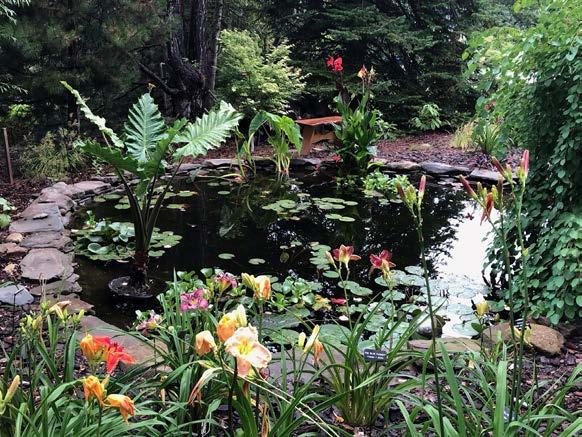
By Carolyn Sperry
Garden tours will take you to a lot of pretty outdoor spaces but there aren’t many like Jed Fox’s. “I don’t know how much I’m allowed to brag,” he says, “or not.” But in recent years, many different garden tours have featured his Pittsford garden. He’s received comments like “Finest private garden I’ve ever seen,” and “I’ve gone to public arboretums, and you put them to shame.” Fox, a dentist, has created, expanded, and maintained the garden himself since moving into the house in 1982. He and his wife, Peggy, chose the home because it was the only one available in Pittsford that was zoned for a home office. The home happened to have an acre and a half of land, and he set to work turning all that space into a one-of-a-kind garden with ponds, a Zen garden, and a children’s garden. He dug the ponds himself, with a backhoe, and built berms around the house. Fox loves daylilies and started breeding his own varieties, simply because he found it to be an easy and fun thing to do. Now he has a stunning 800 varieties.
This year’s Kiwanis Club Garden Tour (July 27) will be the last tour that Fox invites to his garden, as he retired in May and he and Peggy plan to relocate to South Carolina. As much as he’d like to keep both houses, “you can’t fight deer in two places,” he says. He plans to take cuttings with him and start a smaller garden at their new home. As for the fate of the Pittsford house and garden? He hopes to sell it to someone who is “into it.” bushnellsbasinpittsfordkiwanis.org/garden-tour
Anu Scofield is is a lifelong reader and writer studying English and Communications & Media at Nazareth University.

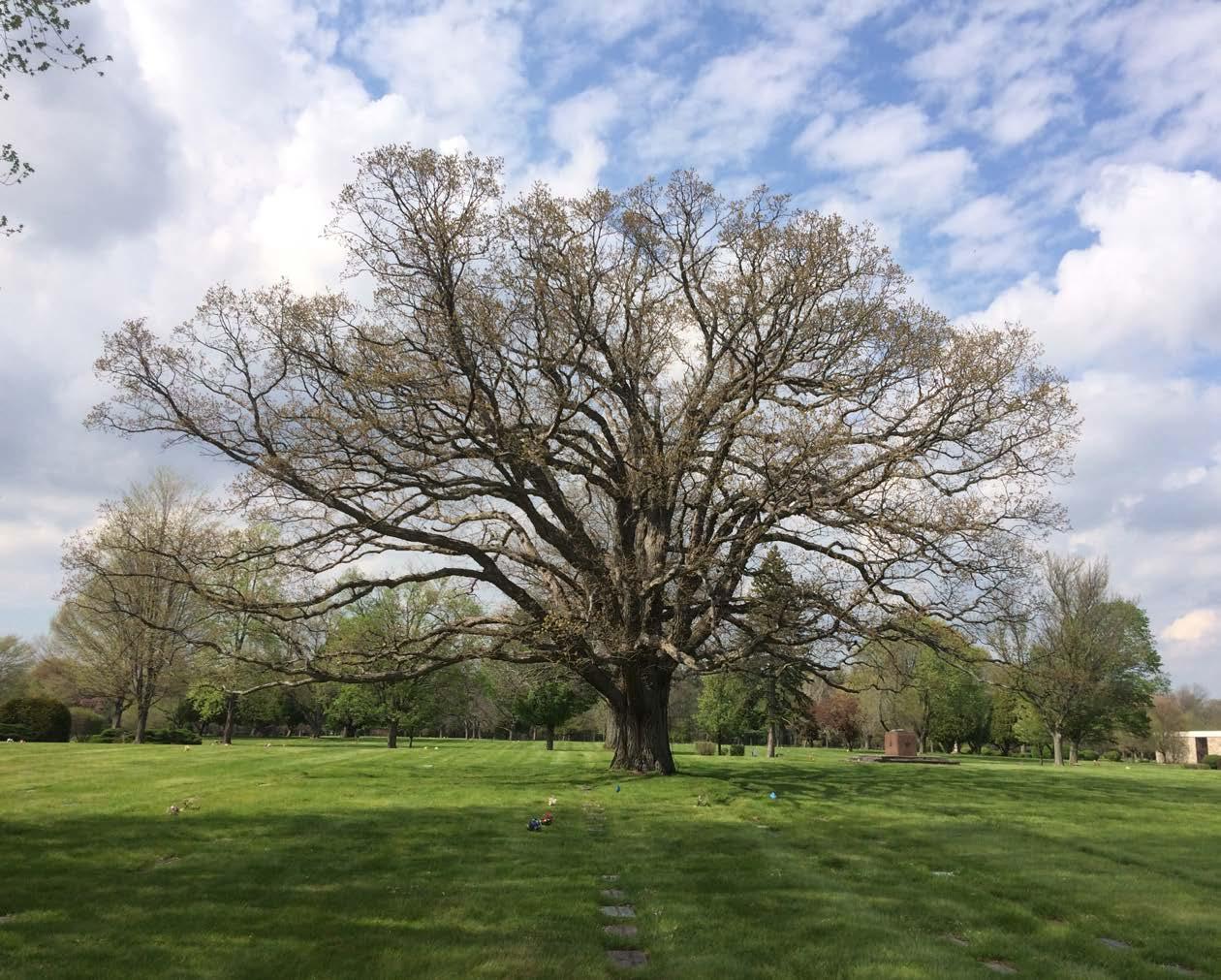
(But maybe don’t look behind the leafy curtain)
WABOVE: A glorious white oak (Quercus alba) at White Haven Memorial Park, a Level I ArbNet Certified Arboretum in Pittsford (where the staff is lovely, and it's more than safe to look behind the curtain!)
hen I was fresh out of grad school, I worked for a botanical garden in the education department. I’d gotten a master’s degree and racked up relevant experiences so that I could be a qualified applicant for one of these plum jobs; once I landed it, I thought I’d stay forever.
I love public gardens with big budgets; they can do outrageous displays and ambitious research. I also love those smaller ones that are underfunded or even in a bit of decline. I often find them to be the most inspiring, because they are permeated with the love of tireless volunteers who are keeping them going to whatever extent they can. In either case, be they world-
class or regional and scrappy, there is much one can learn from public gardens.
The most exciting aspect of my own horticulture education was any time I came in contact with public gardens. I worked and studied in the Virginia Tech Hahn Horticulture Garden, interned at the Holden Arboretum in Ohio, and went on field trips to see dozens of public gardens. I got to live my dream job when I worked in the aforementioned education department of a botanical garden. I walked around hundreds of tree species and through lush gardens whenever I stepped outside my office … the magic of that never faded.
Public gardens include arboreta and botanical gardens. Historically, arboreta have focused on curated collections of woody plants, while botanical gardens have had a broader focus, featuring showy gardens and/ or collections of both woody plants and herbaceous plants. Many public gardens began as private gardens by people who were passionate plant collectors.
Increasingly, college campuses are formally registering as arboreta, maintaining their trees as collections with plant labels, databases, educational programs, and master plans. The University of Rochester campus arboretum is Level II Certified by ArbNet. White Haven Memorial Park in Pittsford is a Level I Certified Arboretum, as is South Park Arboretum in Buffalo. ArbNet certification is one way that an institution shows its desire to invest significantly in the diversity and health of its plant collections.
One of the best ways to learn plants is to visit a public garden in your region at regular intervals throughout the growing season. Arboreta and botanical gardens are the ideal places to learn plant identification; there are often plant labels and many arrange at least some of their collections by plant family to help you in your plant identification studies. If you have the time, you can volunteer to work in a specific garden or in the greenhouse. All of that repetition and observation will pay off. Speaking of volunteers, they seem to be having a lot more fun than the staff at public gardens. So maybe if you venture to take a peek behind the leafy curtain, do it in a volunteer capacity.
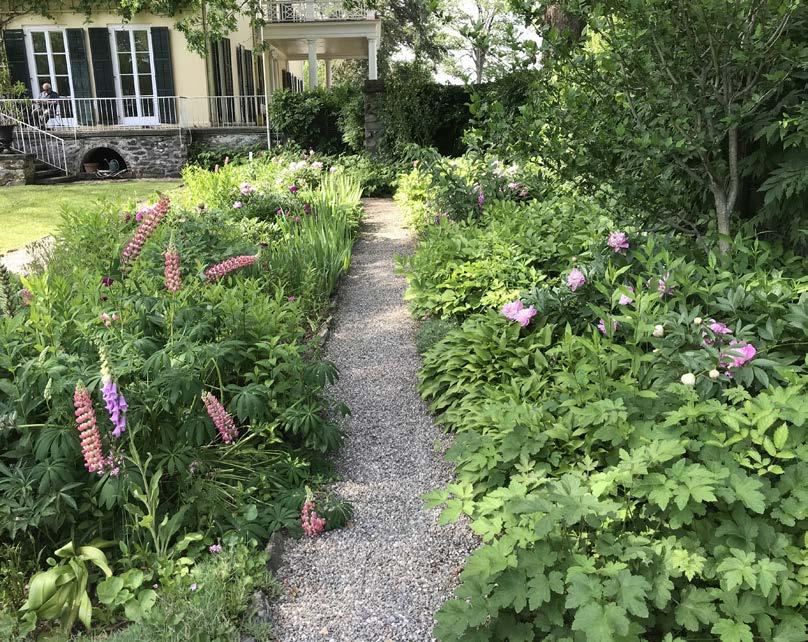

One of many especially memorable container displays at the extraordinary Cornell Botanic Gardens in Ithaca

— • —
ABOVE: An unforgettable smoke tree (Cotinus coggygria) in Rochester’s Highland Park
OPPOSITE TOP: Accession tag
OPPOSITE BOTTOM: Display label
So why did I stay in the job for less than three years? It wasn’t that I didn’t love the work—I truly did, but there were unforeseen forces that came together to propel me westward, to live with my thenpartner. She had a better paying job than I did, and we’d come to a crossroads. During this time, we both sustained injuries and found it extremely challenging to care for each across distance. My beloved boss at the botanical garden became terminally ill. That really shook me up—why her, why now? She was one of the kindest people I’ve ever known. For me, in her absence, rudderless feelings sometimes crept in. And then, the horrific events of 9/11 had me—indeed, most people—reevaluating priorities. The classic work versus family dilemma forced my hand.
I felt guilty about leaving my dream job before fulfilling at least five years, the commitment asked of me when I was hired. But ultimately the botanical garden was better off, too, because I couldn’t sustain the huge amount of extrovert energy that job required. Over time, I’ve accepted that I am introverted and happiest when I work with a few people and have a small, but rich, social circle. Meanwhile, the person
There’s a dark thing that can happen in botanical gardens: plant theft. At the botanical garden where I worked, thieves had stolen some of the rarest plants from the collection. Whoever did it knew a good deal about rare plants and their value on the market That is just the lowest of the low. There is a fascinating post about plant thefts from the Royal Botanical Gardens, Kew, and elsewhere on the Garden History Girl blog; the post is called “Booby-trapped daffodils and a stolen water lily: 100 years of plant thefts.”
who took the botanical job after me has done it for decades, and I truly admire them for their commitment and longevity.
Public gardens are horticultural utopias, and who isn’t drawn to the ideal? So maybe it’s surprising if I tell you that I don’t go visit them very often anymore. For one thing, my midlife passion is birds. But it’s also that when visiting public gardens, I rather quickly find myself feeling very ... tired. I know too much about how much work it takes to keep these landscapes going, and not just the highly manicured ones. Friends, it is SO MUCH WORK. One gardener at the place I worked candidly shared how bored they felt in their job, doing the same things over and over. An arborist there said, “It’s great to work outside, but also, you have to work outside.” Little did he and I know how quickly erratic weather and its extremes would worsen.
In talking with folks who work(ed) at other public gardens, we agree that horticulture as a field tends to draw friendly and interesting people to it. Yet somehow the workplace politics in a public garden can be almost as vexing as anywhere else. Mediations between workers are sometimes necessary. There can be tensions between leadership and the unionized members. Leadership wants to expand the botanical gardens in a historically unprecedented way, but gardeners are understandably worried about how all this additional work would get done. Big donors like to give towards new gardens, but will there be an endowment for maintenance? Workers can be sincerely stressed about what expansion means for them and how it will affect the vibe of the place. Will it become slick and corporate? Can it retain a homey feeling? Can we still bring our dogs to work?
Michelle Sutton is a horticulturist, writer, and editor.


Not all public gardens label their plants, but when you do see a plant label, it could be a display label or an accession tag. A display label usually has the bare bones of ID information: binomial Latin name, common name, and perhaps plant family. By contrast, an accession tag has more collections-based information, often including the nursery from which the plant came, the geographic origin of the species, and an accession number.
The display label above gives you the common name “Bottlebrush Buckeye” and the Latin name (Aesculus x carnea) and cultivar (‘Briotii’). By contrast, the accession tag shown gives you the common and Latin name for an ornamental onion cultivar, Allium thunbergii ‘Ozawa’. It tells you that it’s in the Alliaceae family and that it came from Roslyn Nursery—and it also has an accession number. This number, 06-220A, tells you that this batch of ‘Ozawa’ allium bulbs were accepted into the collections (i.e., accessioned) in 2006; that this batch of alliums was the institution’s 220th accession in 2006; and the A indicates that there are more than one of them in the collections—the others will be labeled B, C, etc. (If there is no letter, that means there was only one of its species acquired at that time.)

NURSERY & GARDEN CENTER
Est. 1927
Monroe County’ s Oldest Nursery
Located near Ellison Park

485 LANDING ROAD NORTH (585) 482-5372
Open 7 Days a Week

Over 3 acres of fresh hardy nursery stock from the common to the hard to find.
Annuals Perennials Fertilizer Seed Bulk Mulch Bagged Mulch Stone Large Selection of Fine Pottery


Installation
Walkways/Patios
Flagstone
Unilock
Brick
Paverstones
Keystone
Foundation Planting
Retaining Walls
Excavation & Grading
Water Gardens
Water Features

Gardening
Mulching
Topsoil
Rototilling
Tree Planting
Tree Removal
Stump Grinding
Shrub Pruning
Theme Gardens
Perennial Gardens
Lawn Care
Lawn Maintenance


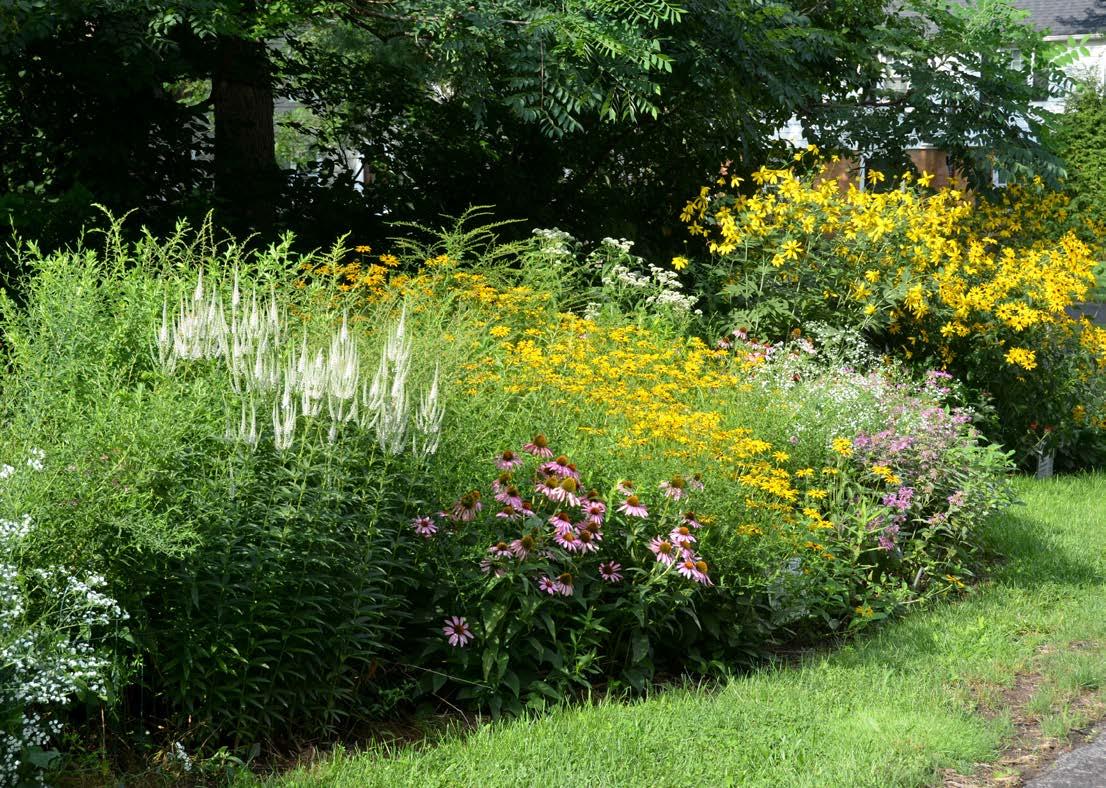
Story and photos by Janet Allen
Ifrequently give tours of my suburban yard, but it’s not the typical garden featured on most tours–those “ooh and ah” gardens of flowerbeds constantly in bloom, neatly mulched, surrounded by perfect velvety lawns. My yard is a habitat garden, full of native plants, self-mulched, with a narrow border of good-enough lawn, interspersed with log-lined mulched paths. When I give a tour, I have some explaining to do! Besides identifying plants, I talk about why we grow them—and the reason is never “because they’re pretty”! Of course, most flowers are pretty, and who could deny the beauty of native plants such as culver’s root (Veronicastrum virginicum)? Also beautiful is the diversity of foliage shapes and colors. For example, though foamflower (Tiarella cordifolia) blossoms are
beautiful, after their brief bloom season ends, the foliage adds beauty of its own as well as serving as a groundcover.
But my yard is full of native plants not because they’re beautiful, but because they support life, now and in the future. An important message I hope visitors take away from my garden tour is that of landscape designer Mary Reynolds: “The time for treating our patches of the planet as blank palettes for our creative expressions is over. Now we need to become guardians, not gardeners, to weave the web of life back together, patch by patch.”
The web of life is woven back together by native plants. Many insects, the foundation of the food web, need particular natives, and increasingly these are missing. Non-native, merely ornamental plants, may
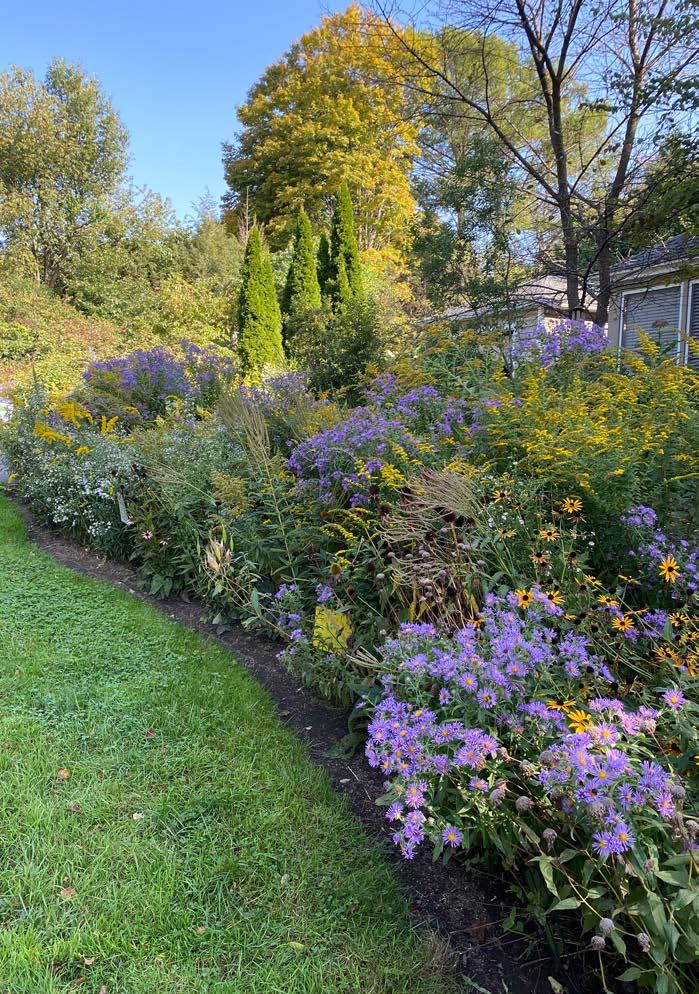
indeed have unblemished leaves and “pretty” flowers but they aren’t weaving together the web of life.
Sadly, I have to report to our tour visitors that I see fewer butterflies and other insects than I had in the past. For example, my pearly everlasting plants (Anaphalis margaritacea) used to be full of American lady caterpillars’ larval nests. Though temporarily unsightly, those whitish blobs became beautiful butterflies, and the plants soon recovered. Fewer butterflies and other insects is a steep price to pay for untouched leaves.
A noticeable difference between the usual ornamental garden and my habitat garden is that there’s no one time when most plants are blooming. My habitat garden is a dynamic, living system. Visitors could return for another tour in a few weeks, and

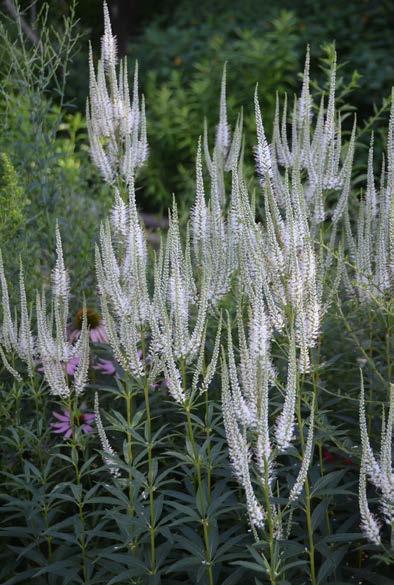
they’d see a different set of plants in bloom.
Whether they’re currently blooming or not, many of the plants have a story to tell. One of my favorite stops on the tour is our twinleaf plant (Jeffersonia diphylla). Its “smiling green Martian” seedpods are intriguing, but more important, I use them as an example of the role of ants in the garden. Ants take the seeds back to their nest, eat their fatty deposits, and then discard them, thus dispersing the seeds. This is a service ants provide for many other plants, too, such as trillium. In fact, contrary to popular belief, ants provide many benefits to gardens.
I also explain why we manage the yard as we do. Since our goal is to support life on earth, we use no pesticides or fertilizers. Our plants thrive in the healthy soil we preserve by leaving the leaves to

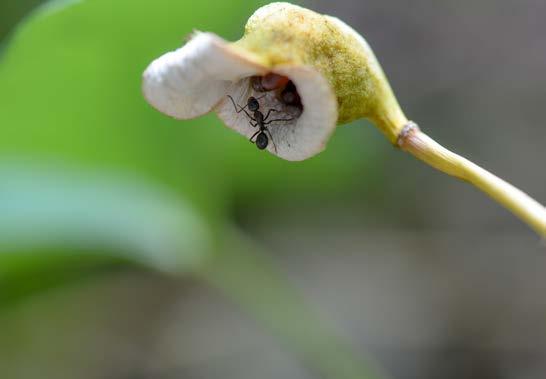

TOP LEFT:
Larval nest of American lady butterfly on pearly everlasting
TOP RIGHT:
Larval nests of the American lady butterfly on pussytoes
BOTTOM LEFT: Twinleaf seedpod
BOTTOM LEFT INSET: Ant with twinleaf seed with its fatty deposit (the elaiosome)
BOTTOM RIGHT: Monarch Waystation sign from Monarch Watch after certifying my yard


decompose, and we protect the soil structure by staying on the paths and using stepping stones in the garden beds.
In addition to protecting biodiversity, we point out measures we take to protect climate, such as leaving space in my smallish yard for a “solar” clothes dryer. And by having a very small lawn, we prevent CO2 emissions from fossil-fueled lawn equipment. Just as important, limiting hardscaping and having lots of greenery from the ground to the top of our tallest trees itself protects the climate by not reflecting heat. It is indeed cool and refreshing in my yard!
In addition to our habitat garden, our tour features a large organic vegetable and fruit garden in the back yard. We hope the sight of all that fresh, delicious food inspires tour visitors to grow at least some of their own food, not only producing healthy food for themselves, but decreasing the amount of plastics and fossil fuels used in industrial agriculture.
Of course, tour visitors wonder how my unconventional landscape is accepted, and I’m happy to report to them that we’ve had many positive comments about our habitat garden. I point out some
design features that are important. First, I didn’t just stop taking care of my yard and just let it grow wild. My beds are intentionally planted, and the front yard features many flowering plants. I maintain a neat curving border between the strip of lawn and the planting beds and have neatly mulched paths. I also display signs from national organizations that explain the purposes of my yard, such as it being a Certified Monarch Waystation. And best of all, our tour visitors themselves find our yard to be beautiful and a very enjoyable place to be!
Finally, as a grandparent, I emphasize to our tour visitors one big idea: We’re rapidly reaching climate and biodiversity tipping points. It’s our obligation to be good ancestors and leave the next generations a living planet. Habitat gardens full of native plants are an essential part of reaching that goal.
Janet Allen’s garden is described on the Our Habitat Garden website ourhabitatgarden.org. She is president of the Wild Ones Habitat Gardening in Central New York chapter (hgcny.org).
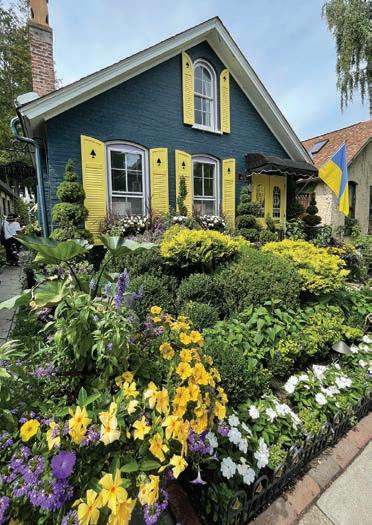

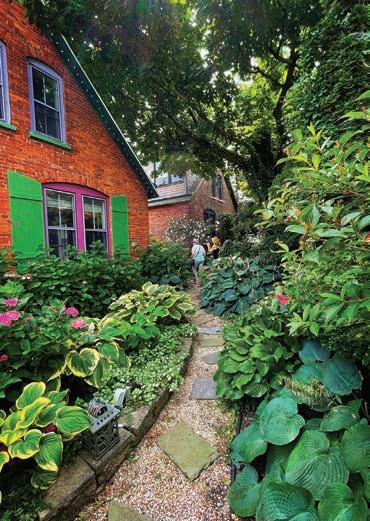







By Liz Magnanti
Bee balm, salvia, coneflower, milkweed, and butterfly bush often come up in the conversation about plants for butterfly gardening. There are, however, some other (possibly unexpected) plants you can add to your garden in order to attract a larger number of butterflies and in turn other pollinators. With garden season now in full swing, I thought it would be a great time to talk about pollinator plants, but specifically, these unexpected plants that can benefit and increase the pollinators in your garden.
There are hundreds of beautiful nectar-producing plants that will attract these butterflies and they are an important part of every butterfly garden. The purpose of this article is to focus on some of the host plants that are vital to the caterpillar stage of the butterfly. It is these plants that the adult butterflies will lay their eggs on, and their caterpillars will feed on. Adding this food source will encourage your garden to attract all stages of butterfly development, not just their adult flying stage. Butterflies have different host plant requirements depending on what species you are trying to attract, so I thought I’d focus on some of the most common butterflies that can be found locally.
Red Admiral butterflies are a species you may be seeing more often in the garden this year. This migratory butterfly is known for also having large population booms and busts and has been prevalent this year. If you see a butterfly flying erratically in your garden, it’s most likely a Red Admiral. When at rest you can see the brilliant red stripe that goes through their black wings. The host plant of the Red Admiral is nettle—whether it be false nettle or stinging nettle, the Red Admiral will lay its eggs on both. The Question Mark and Comma butterflies, sometimes called “Anglewinged” butterflies, will also use nettle as a host plant. If you do any herb gardening, you may have already had experience with Black Swallowtail caterpillars. The Black Swallowtail will lay its eggs on parsley, fennel, dill, and Queen Anne’s lace. Before harvesting herbs and anything in the carrot family, check for their bright orange eggs or spotted caterpillars. I have started planting parsley, dill, and fennel among my nectarproducing plants in hopes of enticing more Black Swallowtails. Another Swallowtail species, the Tiger Swallowtail, will lay its eggs in the treetops of trees like tulip poplar and sweet bay magnolia. If you see a large yellow butterfly flying among the treetops, it is most likely a Tiger Swallowtail.
Large trees can also be host plants. Willows are host plants for butterflies like the Viceroy, Mourning Cloak, and the Red-spotted Purple. Maple trees host a variety of caterpillars—including those of Giant Silk moths like the Cecropia, Polyphemus, Imperial, and Rosy Maple Moths. Oaks are a fabulous host to caterpillars including many Hairstreak butterfly species.
ABOVE: Monarch butterfly on a coneflower. Photo by Christine Green.
When planning a butterfly garden, it’s important to first think about the lifecycle of the butterfly. Like all other insects, butterflies start off as an egg. That egg hatches and out pops a larva, called a caterpillar. During their stage as a caterpillar, the insect will do basically one thing—eat! Once they have eaten their fill of their “host plants” and grown significantly, the caterpillar will pupate and form a chrysalis, or a cocoon if they are a moth. After weeks or sometimes months in their chrysalis, out will hatch the adult butterfly.
Your vegetable plants might be getting nibbled on by another caterpillar from the Cabbage White butterfly. The Cabbage White is an introduced species, but it is probably also the most common butterfly you will see in your garden. These white butterflies will sip nectar from many blooming plants and will lay their eggs on cabbage and other vegetables like broccoli, kale, radishes, cauliflower, and more.
Some common backyard plants that people often pull can also be host plants to butterflies. Plantain is the host plant for the Common Buckeye and Baltimore
Checkerspot. White clover and dandelion are host plants for the Clouded Sulphur. Violets will be used by Fritillaries to lay their eggs on and around.
There are butterfly feeders and houses that can be put in the garden to try to attract more butterflies, but the best thing you can add to your yard besides plants is a butterfly puddler. Butterflies will often congregate around a puddle or damp, muddy place in a behavior known as “puddling.” They will use these wet areas to siphon nutrients from the sand and soil. You can make one of these butterfly puddlers simply with a plant saucer or birdbath. In this small, shallow container, add a mix of sand, soil, rocks and a little salt. Add some water so the puddler is always damp. The rocks will provide landing spots for the butterflies to rest while they siphon out minerals from the soil and sand mixture.
Finally, the most important tip I can give, is to avoid pesticides in the garden. Pesticides will kill the insects you don’t want, but they can also kill beneficial insects which doesn’t give any of the pollinators a fighting chance. You may be very surprised at how avoiding pesticides encourages more natural predators that will eat the creatures you are trying to avoid in the yard.
It’s always fun to create a diversity of color using flowers in the garden, but with the addition of some caterpillar host plants you may start seeing an addition of color from butterflies and other pollinators. Increasing the amount of host plants will provide your garden with the habitat butterflies require to survive and thrive.
Liz Magnanti is co-owner of the Bird House in Brighton.


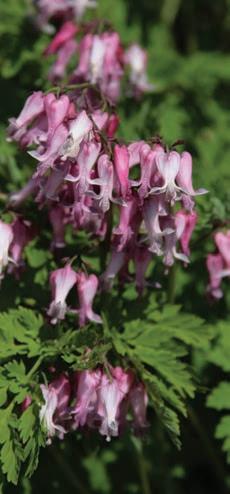

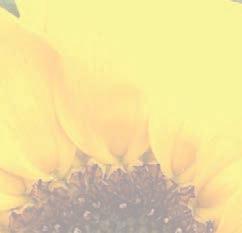




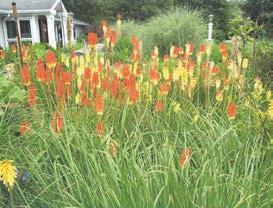



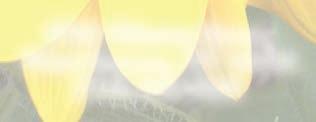
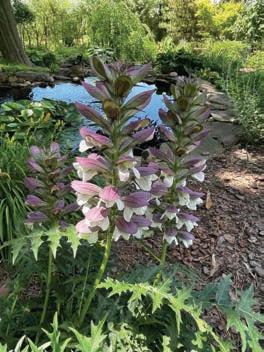


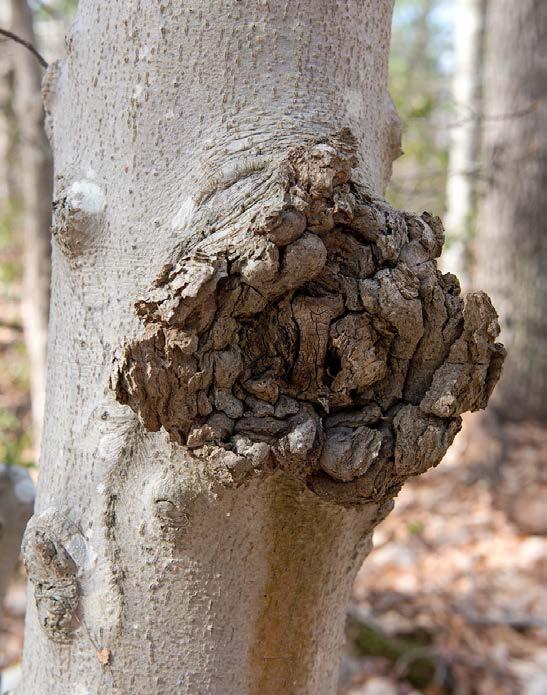

By Beth Mattimore
Iwas dismayed to learn about the beech bark and beech leaf diseases that are threatening these majestic trees. Below is a summary of a recent webinar from the EPA on the beech tree diseases.
Beech trees are “a pillar of the eastern forest ecosystem.” They are foundational trees, prized for their form, structure, dense shady canopy, smooth bark, and nuts. The American beech, Fagus grandifolia , is the twelfth most abundant tree in the United States. New York and New England have the highest densities. Commonly found in mixtures of maples and birch trees, beech trees are the most shade tolerant of any hardwood tree species, a characteristic which allows them to survive in
the understory shade. Beech trees help birds and mammals such as bear, deer, and turkey grouse because their nuts have a high protein content. Unfortunately, there are two distinct threats to beech trees—beech bark disease and beech leaf disease.
The first, beech bark disease, has been in North America for more than 100 years. This disease arises from the interaction of a beech scale insect and fungal infection. The scale insect, a sap feeder that appears on the bark as a white, cottony secretion, produces small wounds on the bark that allow for the entry and infection by two fungal pathogens. Once established, the infection will induce cankering at the infection site. Fungal fruiting bodies may appear as small red dots
in the cankers. Other signs of infection include loss of leaves and broken branches.
Beech bark disease does not kill trees right away, but once infected most trees weaken and die slowly over several years with older, larger trees appearing to be more susceptible. Once infected, the trees become more vulnerable to other fungi which can lead to a structural failure of the trunk called beech snap.
First discovered in Ohio in 2017, beech leaf disease has spread quickly and is now pervasive in forests near Lake Erie and in many locations in New York State. This disease is caused by a foliar nematode; vector transmission is unknown. Mild symptoms show normal sized leaves but areas of discolored banding between the lateral veins. Heavier symptoms will show smaller leaves, curled up at the edges, some with a thick, leathery texture along with chlorosis and necrosis. Symptomatic leaves exhibit a fifty percent reduced rate of photosynthesis and the less efficient use of water, along with a significant deterioration of over and under story with canopy deterioration and branch die back. It can kill a mature tree in six to ten years and saplings in two years.
Control and treatment of these diseases is difficult and not practical in a forest setting. Treatment is a better option for urban landscape trees. No large-scale control methods exist. Ornamental beeches can be treated with insecticides (consult a certified arborist) to stop the scale that leads to beech bark disease. Using a soft brush or strong stream of water to remove the scale from the trunk may help. Horticultural oil can be applied to the trunk. Experts recommend basic good tree care to decrease the stress on the tree. This includes improving the soil, watering during dry periods, providing a large ring of mulch, and avoiding turfgrass competition. Sadly, even with such steps, the disease may advance and result in death. A small number of trees are resistant or show tolerance for the disease which provides hope for future breeding programs. For beech leaf disease, treatment consists of best care practices noted above. Research is underway for reliable treatments. Some early research shows partial control with PolyPhosphite 30, a potassium fertilizer applied twice a year as a soil drench or soil injection that may help smaller trees. A fungicide foliar spray is also an option. Both treatments may produce symptom recovery and lower nematode population densities but do not kill all the nematodes. If interested in these treatments contact a DEC-certified pesticide applicator. Unfortunately, the widespread nature of the disease makes long-term management difficult. It’s anticipated the ongoing research will yield sustainable solutions for these diseases in the future.
The DEC states that the best way to report forest health problems, including the beech leaf disease is through nyimapinvasives.org.
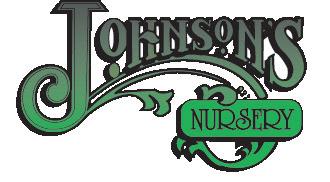
When you’re looking for something unique, say no more— just pay us a visit!
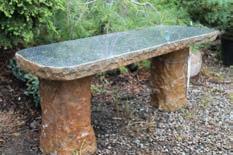
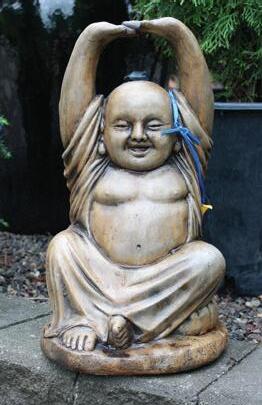
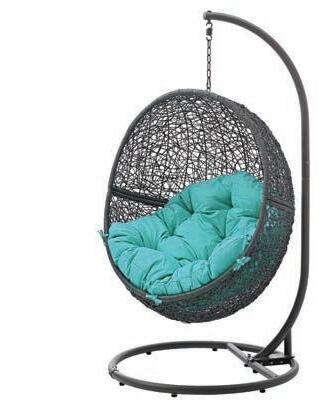
Just 2 1/2 Miles East of Rte 400 11753 East Main St. • East Aurora, NY (716) 652-8969
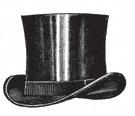
H.A.Treichler & Sons
“We Grow Our Own” A Family Tradition Since 1854
10” Hanging Baskets—Thousands to choose from Annuals & Perennials—Gallons and 4½” Pots Geraniums
Over 25 Varieties of Proven Winners
Vegetable Plants for Home Gardeners • Seeds



Gift Certificates Available
Don’t forget our Senior Discount every Wednesday!
Military Discounts Daily
Open through October 31
Open daily 9 am–5 pm
2687 Saunders Settlement Rd. (Rte. 31), Sanborn 716/731-9390

African Violet & Gesneriad Society of WNY meets the third Tuesday of the month, September–August, at 7 p.m., Greenfield Health & Rehab Facility, 5949 Broadway, Lancaster. avgswny@gmail.com.
Alden Garden Club meets the second Wednesday of the month (except July and August) at 7 p.m., Alden Community Center, West Main St., Alden. New members and guests welcome. Plant sale each May. 716-937-7924.
Amana Garden Club meets the second Wednesday of the month (except January) at Ebenezer United Church of Christ, 630 Main St., West Seneca. Visitors welcome. 716-844-8543, singtoo@aol.com.
Amherst Garden Club meets the fourth Wednesday of the month (except December, March, July, and August) at 10 a.m., St. John’s Lutheran Church, Main St., Williamsville. New members and guests welcome. 716-836-5397.
Bowmansville Garden Club meets the first Monday of the month (except June, July, August, and December) at 7 p.m., Bowmansville Fire Hall, 36 Main St., Bowmansville. New members and guests welcome. For more information, 716-361-8325.
Buffalo Area Daylily Society. East Aurora Senior Center, 101 King St., East Aurora. The society is a friendly group who get together to enjoy daylilies. Plant Sales in August. Open gardens, June–August. Facebook.
Buffalo Bonsai Society meets every second Saturday at 1 p.m. at ECC North Campus, STEM Bldg., 6205 Main St., Williamsville, NY 14221. TBD; 7/13, Terry Monroe, (Pittsburg, PA) deciduous; 8/10, Picnic/Auction; 9/14, Ron Maggio (Rochester, NY) Suiseki; 10/12, Mark Arpag; 11/9, Indoor lighting Christine Wilkolaski buffalobonsaisociety.com.
East Aurora Garden Club meets at noon on the second Monday of each month, except in January. The club meets at Nativity Lutheran Church, 970 E. Main St., East Aurora (just west of the 400 Expressway exit). The club’s objective is to stimulate, create interest, and promote education on horticulture, the art of gardening, flower arranging, and environmental conservation; and to promote the beautification of surrounding areas. For more information about the club or membership, call 716-912-1589.
Federated Garden Clubs NYS–District 8. Nancy Kalieta is the director; nancyk212@aol.com. gardenclubsofwny.com.
Forest Stream Garden Club meets the third Thursday of the month (September–May) at 7 p.m., Presbyterian Village, 214 Village Park Dr., Williamsville, and other locations. Summer garden teas and tours available. Ongoing projects include beautification of the Williamsville Meeting House, garden therapy at a local nursing home, youth gardening, and Victorian Christmas decorating. eileen.s@markzon.com.
Friends of Kenan Herb Club meets the third Monday of the month at 2 p.m. at the Taylor Theater. New members are always welcome. kenancenter.org/ herb-club.
Garden Club of the Tonawandas meets the third Thursday of the month at 6:30 p.m., Tonawanda City Hall, Community Room. Facebook.
Garden Friends of Clarence meets the second Wednesday of the month at 7 p.m., September–June, Town Park Clubhouse, 10405 Main St., Clarence. gardenfriendsofclarence@hotmail.com.
Gardens Buffalo Niagara open gardens on Thursdays and Fridays in July starts Thursday, July 11. Explore the beauty of gardens spread out in Erie and Niagara counties. Visit gardensbuffaloniagara.com/
open-gardens-buffalo for more details and location information.
Hamburg Garden Club meets the second Wednesday of the month at 10 a.m. at the VFW Post 1419, 2985 Lakeview Rd., Hamburg. Events include a June plant sale and summer garden tours. Guests are welcome. Contact lonabutler4@gmail.com.
Kenmore Garden Club meets the second Tuesday of the month (except July, August, and December) at 10 a.m., Kenmore United Methodist Church, 32 Landers Rd., Kenmore. Activities include guest speakers, floral designs, and community service. New members and guests are welcome. songnbird@ aol.com.
Ken-Sheriton Garden Club meets the second Tuesday of the month (except January) at 7 p.m., St. Mark’s Lutheran Church, 576 Delaware Rd. Kenmore. Monthly programs, artistic design, and horticulture displays. New members and guests welcome. 716833-8799, dstierheim@gmail.com.
Lancaster Garden Club meets the second Wednesday of the month (except January, July, and August) at 7 p.m., St. John Lutheran Church, 55 Pleasant Ave., Lancaster. All are welcome. Facebook.
Lewiston Garden Club meets the fourth Monday of the month. See website for meeting information, lewistongardenfest.com/garden-club.html or contact at PO Box 32, Lewiston, NY 14092.
Niagara Frontier Botanical Society meets the second Tuesday of the month September through May at 7:30 p.m. (except April) at the Harlem Rd. Community Center, 4255 Harlem Rd., Amherst. Entrance is on the north side of the building. Meetings are open to the public.
Niagara Frontier Orchid Society (NFOS) meets the first Tuesday following the first Sunday (dates sometimes vary due to holidays, etc.), September–June, Botanical Gardens, 2655 South Park Ave., Buffalo. niagarafrontierorchids.org.
Orchard Park Garden Club meets the first Thursday of the month (except July and December) at 11:30 a.m. at St. John’s Lutheran Church, 4536 South Buffalo St., Orchard Park. Contact Diana Szczepanski at 716674-8970 for membership information. Guests are always welcome.
Ransomville Garden Club meets the third Wednesday or Saturday of the month at 5:45 p.m., Ransomville Community Library, 3733 Ransomville Rd., Ransomville. Meetings are open to all. Activities include community gardening projects, educational presentations, and June plant sale. bbonnie2313@ gmail.com.
Silver Creek-Hanover Garden Club meets the second Saturday of the month at 11 a.m., Silver Creek Senior Center, 1823 Lake Rd. (Rte. 5), Silver Creek. schgardenclub2010@gmail.com
South Towns Gardeners meets the second Friday of the month (except January) at 9:30 a.m., West Seneca Senior Center. New members welcome.
Springville Concord Garden Club meets the second Monday of the month at 1:30 p.m. at the Concord Senior Center, 40 Commerce Dr., Springville. Meetings feature guest speakers on a variety of gardening and related topics. Annual July Garden Walk. Guests are welcome.
Town and Country Garden Club of LeRoy meets the second Wednesday of the month (except February) at 6:30 p.m., First Presbyterian Church, 7 Clay St., LeRoy. Prospective members and guests are welcome. Contact: leroynygardenclub@gmail.com. Facebook: facebook.com/GardenClubLeRoyNY.
Town and Country Garden Club of Williamsville generally meets the second Thursday of the month from 2 to 4 p.m. at the Ransom Oaks Community Club House, 101 Ransom Oaks Dr., East Amherst. Some meetings are held off site for garden tours and special events. The club maintains a garden at
the Clearfield Library, 770 Hopkins Rd. Membership brochures with program information are available in the library. For information, contact Lanscombe@ roadrunner.com.
Tropical Fish Society of Erie County meets the third Tuesday of the month at 7:30 p.m., Lake Erie Italian Club, 3200 South Park Ave., Lackawanna, NY 14218. tropical-fish-club-of-erie-county.com
Western New York Herb Study Group meets the second Wednesday of the month at 7 p.m., Buffalo and Erie County Botanical Gardens, 2655 South Park Ave., Buffalo. Facebook.
Western New York Honey Producers, Inc. Cornell Cooperative Extension of Erie County, 21 South Grove St., East Aurora. wnyhpa.org.
Western New York Hosta Society. The WNYHS was formed to encourage members to appreciate hostas and to provide them with access to quality new varieties. The group meets three times a year at the East Aurora Senior Center, 101 King St., East Aurora. Wnyhosta.com.
Western New York Hosta Society Breakfast Meetings are friendly get-togethers the first Saturday (winter months only) at 10 a.m., Forestview Restaurant, Depew. Wnyhosta.com.
Western New York Iris Society meets at the Julia B Reinstein Library, 1030 Losson Rd., Cheektowaga, NY at 1:30 p.m. on the first Sunday of each month
Western New York Rose Society meets the third Wednesday of each month at 7 p.m., St. StephensBethlehem United Church of Christ, 750 Wehrle Dr., Williamsville. Check the Facebook page or website for meeting content; wnyrosesociety.net.
Youngstown Garden Club meets the second Wednesday of every month at 7 p.m., First Presbyterian Church, 100 Church St., Youngstown. Facebook.
BECBG: Buffalo & Erie County Botanical Gardens, 2655 South Park Ave., Buffalo, NY 14218. 716/827-1584; buffalogardens.com.
DRAV: Draves Arboretum, 1815 Sharrick Road, Darien, NY 14040. 585-547-3341; dravesarboretum.org
REIN: Reinstein Woods Nature Preserve, 93 Honorine Drive, Depew, NY 14043. 716-6835959; reinsteinwoods.org.
F- Indicates activities especially appropriate for children and families.
S- Indicates plant sales/swaps.
T- Indicates garden tours.
O-Indicates online events.
Ongoing: First Wednesday of the Month for 2024: Free Community Nights, 5–8 p.m. Visitors can enjoy free admission the first Wednesday evening of the month. Sponsored by Assemblyman Pat Burke. BECBG
Ongoing: Hamburg Farmers’ Market Open Saturdays rain or shine and on all holiday weekends, May 4–Oct. 26, 2004, 7:30 a.m.–1 p.m. Located at the Hamburg Moose Lodge, 45 Church St., Hamburg, NY 14075, More info on the web @hamburgfarmersmarket or the website southtownsregionalchamber.org for more details.
F July 6: Family Wellness Walk, 10:30 a.m. This is a relaxing walk in the woods. Registration required;
call 716-683-5959. REIN
F July 6: Woods Walk: Turtles, 1 p.m. It’s summer—and if the sun is out, so are the turtles. We’ll check out their habitats and see what we can find. No registration required. REIN
July 10: Senior Stroll, 10 a.m. Walkers can enjoy a leisurely hour-long guided walk through the woods. For adults only. Registration required. REIN
July 10, 17, 24: Firefly Walk, 8:30 p.m. Walkers will experience the bioluminescent world of fireflies on this guided walk. Registration required. REIN
July 13: Friends of Reinstein Woods Artisan Market, 11 a.m.–4 p.m. This event includes hopping along the trails at Reinstein Woods. Artisan will sell handmade soaps, candles, jewelry, fine woodwork, honey, and other hand-crafted items. Admission is free (a $2 donation to Friends of Reinstein Woods is appreciated). Rain or shine event. REIN
T July 13: Draves Arboretum seventh annual open tour, 1:30-3:30 p.m. $12 per person. This tour an excellent opportunity for the public learn more about the arboretum and experience its woody species collections through a guided tour of the grounds. DRAV
July 13: at the Elmwood Village Farmers Market, 8 a.m.–1 p.m. this event includes a joyful and affirming butterfly release, bring your kids or whoever needs their spirits lifted! Location: North end of Elmwood Village Farmers Market on Bidwell Parkway near West Delavan. Gardensbuffaloniagara. com/conservation-day-on-bidwell-parkway-1
S July 13–14: Hamburg Garden Club Sale, 10 a.m.– 4 p.m. Gardening items for sale. Learn about club projects and how you can become involved. Union St. and Lake St., Hamburg, NY.
F, T July 19–20: Ken-Ton Garden Tour Night Lights, 8:30–11 p.m. Tours in charming, familyfriendly neighborhoods just north of Buffalo kentongardentour.com
July 20: Pond MacroBlitz, 10 a.m. Aquatic insects can tell people about water quality. Attendees will scoop in the pond for macroinvertebrates and collect data for National Geographic’s MacroBlitz community science program. Registration required; call 716683-5959. REIN
July 20: Woods Walk: Butterflies, 1 p.m. They’ve been out for a while, but summer is considered peak season for butterflies. No registration required. REIN
T July 20–21: Ken-Ton Garden Tour Day Tour, 10 a.m.–4 p.m. This annual tour is celebration of color that showcases the hard work and dedication of local gardeners. kentongardentour.com
T July 20–21: Eastside Garden Walk, 10 a.m.–4 p.m. Visitors are invited to tour more than 100 gardens with participating gardeners and experience Buffalo’s East Side’s historic neighborhoods and wide-ranging architecture. gardensbuffaloniagara. com/esgw
July 26: Nighttime Moth Survey, 8:30 p.m. The night offers a different world of insects that is less often explored. Registration required. REIN
T July 27-28: Garden Walk Buffalo, 10 a.m.–4 p.m. Garden Walk Buffalo attracts visitors from around the US, Canada, and beyond. More than 300 creative and gracious gardeners will open their gardens. gardensbuffaloniagara.com/garden-walkbuffalo
F July 27: Family Nature Quest: Woodpeckers, 10:30 a.m. Visitors will look for signs and sightings of the many woodpeckers that call Reinstein Woods their home. Registration required. REIN
July 31: Going Batty! 8 p.m. Bats are amazing animals but are often misunderstood. This presentation will separate fact from fiction about the only true flying mammals. Registration required. REIN
F July 8–12, 22–26, 29 to August 2, 5–9: Summer Nature Week, 10–11:30 a.m. For parents and children ages 2–8. Explore, discover, craft, play games, and learn about nature. Friday sessions spent at the stream. For more information and to register go to friendsoffiverivers.org.
August 3: Summer Forest Bathing, 9:30 a.m. This walk will focus on the sights, sounds, and smells of the forest to induce relaxation and ease stress. Registration required. REIN
August 3: Woods Walk: Aquatic Insects, 1 p.m. Fresh water covers less than one percent of the Earth’s surface, but six percent of insects spend one or more life stages in aquatic habitats. No registration required. REIN
August 6–8: Summer Teacher Institute: Environmental Experiences for Great Lakes Educators, 9 a.m.–3:30 p.m. Three days of field trips with classroom connections and peer conversations. Students will learn about local environmental issues and initiatives, understand connections between historical land use and current events, and explore place-based learning opportunities for students. REIN
August 10: I Bird NY, 10 a.m. Search for the birds that call Reinstein Woods home for the summer and start the I BIRD NY challenge. Registration required. REIN
August 14: Senior Stroll, 10 a.m. Experience nature at an individual pace and enjoy a leisurely hour-long guided walk through the woods. For adults only. REIN
F August 17: Stories in the Woods, 10:30 a.m. Enjoy hearing a nature story, followed by a guided walk in the woods. For children ages 3–7. Registration required. REIN
August 17: Woods Walk: Nature Guide’s Choice, 1 p.m. Walkers will take a guided nature walk through the woods. No registration required.
August 17: Urban Farm Day, 10 a.m.–3 p.m. Visitors can interact with growers and groups that strengthen and support the food community. There will be talks, tours, markets, and activities throughout the day. gardensbuffaloniagara.com/urban-farm-daytour
August 19: Sturgeon Full Moon Walk, 7:30 p.m. Walkers will learn fun facts about Great Lakes sturgeon on this moonlit walk. Registration required. REIN
F August 24: Family Nature Quest: Forests, 10:30 a.m. Take a leisurely stroll through the woods to discover how forests help humans, and how humans can help forests and the creatures that call it home. Registration required. REIN
F August 31: Family Wellness Walk, 10:30 a.m. Families can take a relaxing walk in the woods. Registration required. REIN
Adirondack Chapter, North American Rock Garden Society (ACNARGS) Meetings are open to all. Check the current newsletter on the website for meeting location: acnargs.org or Facebook.com/acnargs.
Auraca Herbarists, an herb study group, usually meets the second Tuesday of the month at noon, Cornell Botanic Gardens, Ithaca. Brown bag lunch at noon followed by the program and herb of the month. Field trips during the growing season. All are welcome. Contact: Pat Curran, pc21@cornell.edu.
Elmira Garden Club meets the first Thursday of the month, April–December, at 6 p.m., 426 Fulton St., Elmira. Annual plant sale, workshops, monthly meetings, local garden tours and community gardening services. Karen Coletta, 607-731-8320, Facebook.
Finger Lakes Native Plant Society meetings are usually on the third Tuesday of the month September to May. They are an organization dedicated to promoting the appreciation of native flora and hold free public field trips, free indoor programs, and provide members a newsletter, seed exchange, native plant sale, and a December celebration of native plants. flnps.org, info@flnps.org.
Windsor NY Garden Group meets the second and fourth Tuesdays of the month at 10 a.m., members’ homes or Windsor Community House, 107 Main St., Windsor. windsorgardengroup.suerambo.com.
F- Indicates activities especially appropriate for children and families.
S- Indicates plant sales/swaps.
T- Indicates garden tours.
O-Indicates online events.
T July 14: Ithaca Fall Creek Garden Club Garden Tour, 11 a.m.–3 p.m. A free, self-guided annual tour to highlight a variety of urban gardens and gardeners. Garden hosts will be present to answer questions. Before starting, visitors are asked to pick up a map with garden locations and descriptions at Thompson Park at the corner of Cayuga St. and Cascadilla Creek. While at the park, attendees can buy raffle tickets for prizes (drawing at 2:30 p.m.) donated by local garden centers. The Garden Club will also be selling colorful T-shirts featuring its woodcut logo.
7th District Federated Garden Clubs New York State, Inc. meets the first Wednesday of the month. 7thdistrictfgcnys.org.
African Violet and Gesneriad Society of Rochester meets the first Thursday of the month September–November and March–May, 7–9 p.m. at Messiah Lutheran Church, 4301 Mt. Read Blvd., Rochester, NY 14616. December and June meetings are social events TBD location. Contacts: Douglas Burdick, 585-313-8674, dburdick@msn.com. Barb Festenstein, 585-461-1673, barbfestenstein@aol.com.
Bloomfield Garden Club meets the third Thursday of the month at 11:45 a.m., Veterans Park, 6910 Routes 5 & 20, Bloomfield. Visitors and prospective new members welcome. Marlene Moran, 585-924-8035, Facebook.
Bonsai Society of Upstate New York meets the fourth Tuesday of the month at the Brighton Town Park Lodge, Buckland Park, 1341 Westfall Rd., Rochester. 585-334-2595, Facebook, bonsaisocietyofupstateny. org.
Canandaigua Botanical Society meets for in-person botanical events. See website for event schedule. canandaiguabotanicalsociety.blogspot.com
Color Pittsford Green meets on the third Wednesday of the month, 6:45–7:45 p.m. via Zoom. All are welcome. colorpittsfordgreen.org
Conesus Lake Garden Club meets the third Wednesday of the month (April–December) at 7 p.m., Chip Holt Nature Center, Vitale Park, Lakeville. Welcoming new members. Contact Dottie Connelly, 585-703-1748.
Country Gardeners of Webster This club is for those who like to dig in the dirt, smell the roses, learn about the birds and bees, take a walk in the park, eat, drink, and be merry, or live in Webster. They meet the second Monday of the month. Contact Elaine at 585-350-8270 to try this fun-loving club out.
UPSTATE GARDENERS’ JOURNAL | 21
2675 Geneseo Road (Rt. 39) Avon, New York 14414 (585) 226-3073 | palmitersgardennursery.com

Growing great gardens in the Genesee Valley for more than 40 years!

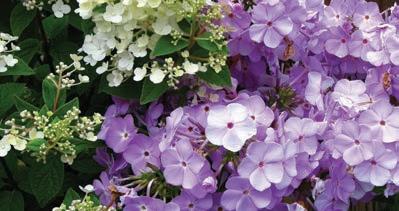
PEONIES —TREE, HERBACEOUS AND INTERSECTIONAL HOSTA, HELLEBORUS, PERENNIALS CACTI AND SUCCULENTS
SPECIMEN JADE TREES
DECORATIVE GARDEN POTTERY TUFA ROCK, DWARF CONIFERS, UNUSUAL TREES
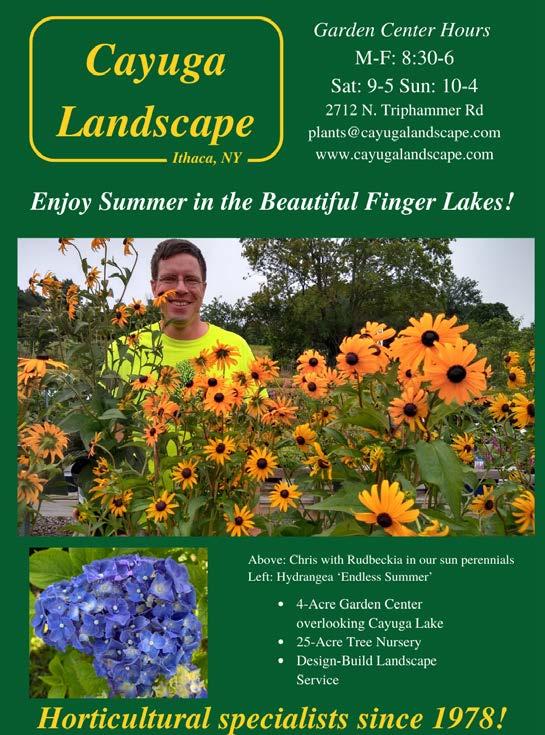








EastAmherst (716)636-7824 baddingbrosfarm.com






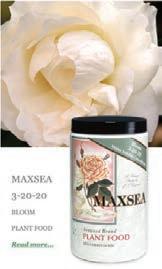
MAXSEA combines the best of nature and technology. We blend the finest natural seaweed with important secondaries, micronutrients and the purest plant foods available.
The resulting complexes are remarkably effective, easy-to-use concentrates that dissolve instantly and completely in water... for fast acting, immediate results. In solution,


MAXSEA's natural brown granules turn dark seaweed green and have the fresh, clean aroma of the sea... a pleasure to use and completely safe for the environment.
Professional growers and home gardeners alike tell us our MAXSEA plant foods are the finest available anywhere. We're very proud of that.
a retail dealer location near you by visiting: www.maxsea-plant-food.com Interested in becoming a dealer? Contact your Sales Rep: Tom Suffoletto / Toms Greenworks 716-225-6891 / tom@tomsgreenworks.com
Creative Gardeners of Penfield meets the second Monday of the month (except July and August) at 9:15 a.m., Penfield United Methodist Church, 1795 Baird Rd., Penfield. Visitors welcome. Contact 585385-2065 or 09green17@gmail.com if interested in attending a meeting.
Fairport Garden Club Meets the third Thursday evening of the month (except January, February, March, and August) in members’ homes or in the Perinton Ambulance building. Educational topics are presented through speakers, workshops, local tours, and community gardening i.e., Planter at Johanna Perrin School. fairportgc@gmail.com, fairportgardenclub.com.
Finger Lakes Daylily Society members garden in west-central NY, covering an area from Batavia to Syracuse and the Southern Tier. Meetings are held in Rochester or the Canandaigua area. There are generally four regular Saturday meetings held in February, March, May, and September. Visitors and prospective new members are welcome to attend. Contact Deb Lawrence for information, binxers1@ yahoo.com.
Friends of Ellwanger Garden meet all season long on Tuesday mornings. To volunteer at the garden, please contact Cindy Boyer at 585-546-7029, x12 or cboyer@landmarksociety.org.
Garden Club of Brockport meets the second Wednesday of every month at 7 p.m., Jubilee Church, 3565 Lake Rd., Brockport. Visitors can learn gardening tips from knowledgeable speakers, make garden ornaments through hands-on classes, and explore beautiful local gardens. For more info call or email Kathy, 585-431-0509 or kathyd5950@gmail.com.
Garden Club of Mendon meets the third Tuesday of the month, 10 a.m.–1 p.m., Mendon Community Center, 167 North Main St., Honeoye Falls. Members work on community gardens and gather new ideas in a casual, social environment. 585-624-8182, joanheaney70@gmail.com.
Garden Path of Penfield meets the third Wednesday of the month, September–May at 7 p.m., Penfield Community Center, 1985 Baird Rd., Penfield. Members enjoy all aspects of gardening, new members welcome. gardenpathofpenfield@gmail. com.
Gates Garden Club meets the second Thursday of the month (except July and August) at 6:30 p.m., Gates Town Annex, 1605 Buffalo Rd., Rochester. New members and guests welcome. 585-247-1248, scece6@yahoo.com.
Genesee Region Orchid Society (GROS) meets the first Monday following the first Sunday of the month. Meetings are held at 6 p.m. at the JCC on Edgewood Dr in Brighton. See the website for information, geneseeorchid.org.
Genesee Valley Hosta Society meets the second Thursday of the month, April–October, at Eli Fagan American Legion Post, 260 Middle Rd., Henrietta. 585-889-7678, sebuckner@frontiernet.net, geneseevalleyhosta.com.
Greater Rochester Iris Society (GRIS) is an affiliate of the American Iris Society, meets on a Sunday during the months of March, April, September, and October at 2 p.m., St. John’s Episcopal Church Hall, 11 Episcopal Ave., Honeoye Falls, NY. Public welcome. Plant Sales, guest speakers or location visits, Volunteer Opportunities. Honeoye Falls, NY. 585-266-0302, thehutchings@mac.com
Greater Rochester Perennial Society (GRPS) meets the first Thursday of each month at 7 p.m., Twelve Corners Presbyterian Church Fellowship Hall, 1200 South Winton Rd., Rochester, except in summer when it tours members’ gardens. Lectures are held virtually, and garden tours are being scheduled. See website or Facebook for updates. cap704@
frontiernet.net, rochesterperennial.com, facebook. com/GreaterRochesterPerennialSociety
Greater Rochester Rose Society meets the first Tuesday of the month at 7 p.m. on Zoom January, February, and March Email j.chorder@gmail.com for meeting link. Questions: 585-694-8430. Facebook: Greater Rochester Rose Society.
Henrietta Garden Club meets the second Wednesday each month (except May–August and December) at 6:30 p.m. A presenter will speak on gardening related subject at 7 p.m. Guests and non-residents are welcome. Handicap accessible. Call 585-7810278. Lower level of the Henrietta Town Hall, 475 Calkins Rd., Henrietta. sites.google.com/site/ henriettagardenclub.
Holley Garden Club meets the second Thursday of the month at 7 p.m., Holley Presbyterian Church. 585638-6973.
Hubbard Springs Garden Club of Chili meets the third Monday of the month at 6:30 p.m. at the Chili Community Center, 3237 Chili Ave., Rochester. dtoogood@rochester.rr.com
Ikebana International Rochester Chapter 53 meets the third Thursday of each month (except December and February) at 10 a.m., First Baptist Church, Hubbell Hall, 175 Allens Creek Rd., Rochester. 585301-6727, 585-402-1772, rochesterikebana@gmail. com, ikebanarochester.org.
Kendall Garden Club meets the first Wednesday of the month at 7 p.m., Kendall Town Hall. 585-370-8964.
Klemwood Garden Club of Webster meets the second Monday of the month at 7 p.m. (except January and February) in members’ homes or local libraries. Accepting new members. 585-671-1961.
Lakeview Garden Club (Greece) meets the second Wednesday of the month (except January and February) at 7 p.m., meeting location varies depending on activity. Meetings may include a speaker, project or visits to local garden-related sites. New members always welcome. Contact Darlene Markham, dmarkham@rochester.rr.com.
Newark Garden Club meets the first Friday of the month at 1 p.m., Park Presbyterian Church, Newark. Guests are welcome.
Pittsford Garden Club Pittsford Garden Club meets the third Tuesday of the month at 10:30 a.m. at the Spiegel Center on Lincoln Ave. in the Village of Pittsford. The club usually meets in Room 18, but visitors should confirm at the front desk. New members are always welcomed. Annual plant sale on the third Saturday in May, parking lot behind the library. pittsfordgardenclub@gmail.com
Rochester Dahlia Society meets the second Saturday of the month (except August and September) at 12:30 p.m., Trinity Reformed Church, 909 Landing Rd. North, Rochester. Visitors welcome. See website for up-to-date information concerning meetings and shows. 585-865-2291, Facebook, rochesterdahlias.org.
Rochester Herb Society meets the first Tuesday of each month (excluding January, February, and July) at noon, Pittsford Community Center, 35 Lincoln Ave., Pittsford, NY. Summer garden tours and day trips. New members welcome. rocherbsociety.com.
Rochester Permaculture Center meets monthly to discuss topics such as edible landscapes, gardening, farming, renewable energy, green building, rainwater harvesting, composting, local food, forest gardening, herbalism, green living, etc. Meeting location and details: meetup.com/ rochesterpermaculture.
Seabreeze Bloomers Garden Club meets the fourth Wednesday of the month (except January) at 7 p.m., location varies depending on activity. Meetings may include a speaker, project, or visit to local gardenrelated site. Monthly newsletter. New members welcome. Meetings are currently canceled, contact Bonnie Arnold with any questions. Bonnie Arnold, 585-230-5356, bonniearnold@frontiernet.net.
Stafford Garden Club meets the third Wednesday of the month (except December and January) at 7 p.m., Stafford Town Hall, 8903 Morganville Rd. (Route 237), Stafford. All are welcome. 585-343-4494.
Urban Agriculture Working Group (UAWG) meets via Zoom on the third Thursday of the month at 7 p.m. UAWG is a collection of gardeners, community gardens, and individuals who garden/farm in the city or support such activities. UAWG offers a Spring Conference each year and sponsors the Urban Gardens ROC garden crawl in the fall. In addition, the group advocates for City policies that make urban gardening more accessible for people who want to grow fresh vegetables for themselves or their neighbors. If you are interested in getting on the email list, contact Mallory Hohl, mdh286@ cornell.edu. You do not have to live in the city to participate.
Victor Garden Club meets the second Wednesday of the month (except January and February) at 6 p.m. New members welcome. Meeting and location details: victorgardenclubny2.com, victorgardenclub.org.
Williamson Garden Club. Ongoing community projects and free monthly lectures to educate the community about gardening. Open to all. 315-524-4204, grow14589@gmail.com, growthewilliamsongardenclub.blogspot.com.
BGC: Broccolo Garden Center, 2755 Penfield Road, Fairport 14450. 585-424-4476; broccolotreeandlawn.com.
CCE/GC: Cornell Cooperative Extension, Genesee County, 420 East Main St., Batavia, NY 14020. 585-343-3040, ext. 132; genesee.cce. cornell.edu.
GCVM: Genesee Country Village & Museum, 1410 Flint Hill Rd., Mumford, NY 14511. 585/5386822; gcv.org.
F- Indicates activities especially appropriate for children and families.
S- Indicates plant sales/swaps.
T- Indicates garden tours.
O-Indicates online events.
July 18: Flower Show hosted by the 7th District Federated Garden Clubs, 1 p.m.–5 p.m. The theme of the show, “A Floral Century,” is a celebration of the garden club’s 100 years of activities. The public is invited to view the floral displays and be inspired. Admission and parking is free. Webster Golf Club, 440 Salt Road, Webster, NY.
T July 20: Stunning Gardens—By Ordinary People, 11 a.m.–4 p.m. (Rain date July 21) The Seymour Library Foundation is hosting a tour of seven gardens in the Brockport area. Reservations are $25 per person and can be made at the Seymour Library, 161 East Avenue, Brockport, by email at seymourlibraryfoundation@gmail.com, or by phone at 585-637-1050. Funds will be used in support of the Seymour Library.
T July 27: Kiwanis Club Garden Tour, 11 a.m.–4 p.m. Rain or shine. Five extraordinary gardens: three in Pittsford, two off Allens Creek Rd., Rochester, NY. Pre-show tickets $18 at Canandaigua National Bank locations. For additional information visit facebook. com/BushnellsBasinPittsforNYKiwanis or call 585415-6035
F July 24–28: Genesee Valley Great Outdoors Week Visitors can explore ways to engage with the great outdoors in this area through a variety of activities. See website for details. GCVM
July 26–28: LotusFest 2024 Bergen Water Gardens Celebrate lotus blooming season at Bergen Water Gardens 7443 Buffalo Rd., Churchville, NY. bergenwatergardens.com
O August 8: Garden Talk “What are Weeds Good For?” Noon–1 p.m. Weeds serve many useful functions: food, herbal remedies, removing toxins, preventing erosion, and even indicating soil types. Free. Register to attend in-person Held at CCE Genesee office, 420 E. Main St., Batavia. CCE/GC
S August 10–11: Greater Rochester Iris Society Iris Rhizome Sale, 10 a.m.–4 p.m. Tried and true rhizomes from members’ gardens as well as new hybridizer’s varieties at great prices. There will also be information on the planting and care of iris from society members. Bristol’s Garden Center, 7454 Rte. 96, Victor, NY
August 24: Learn How to Make Hypertufa Pots, 10 a.m.–11:30 a.m. Make beautiful garden containers that will last for years with the wonderful Hyper Tufa technique. Each student creates their own pot to take home. Ages 14 and up. Cost is $35. BGC
SAVE THE DATE…
S September 14: Fall Garden Gala, 10 a.m.–1 p.m. Plant sale featuring a selection of perennial plants and houseplants, Chance Auction, book sale, and fresh flower arrangements. CCE/GC
African Violet & Gesneriad Society of Syracuse meets the second Thursday of the month, September–December and March–May. Pitcher Hill Community Church, 605 Baily Rd., North Syracuse. 315-492-2562. jimviolets@verizon.net.
Baldwinsville Women’s Garden Club meets the first Thursday of each month except January at St. Mark’s Lutheran Church in Baldwinsville at 7 p.m. The club plants the village flower barrels, raises money for the village flower hanging baskets, maintains the Pointe Garden, donates Arbor Day trees to schools, and gets involved in village improvement projects. Perennial sale yearly on Memorial Saturday morning in the village. See more information at Facebook, Women’s Garden Club of Baldwinsville. Bonsai Club of CNY (BCCNY) meets the first Saturday of the month 10 a.m.–12 p.m., Pitcher Hill
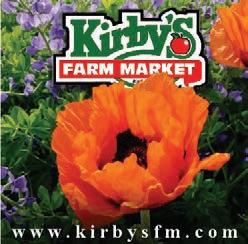
Community Church, 605 Bailey Rd., North Syracuse. Contact Dave Taylor, daveturf1@yahoo.com or 315395-3018. cnybonsai.com, Bonsai Club of CNY on Facebook.
Cazenovia Garden Club usually meets the first Tuesday of the month at 10:15 a.m. at the Cazenovia Public Library. With an active membership, their objective is to stimulate interest in horticulture, develop skills in the beautification of community and home, and create awareness of national and local conservation issues. Meetings feature guest speakers and field trips are planned throughout the year. For more information contact cazgardenclub@gmail.com.
Central New York Orchid Society meets the first Sunday of the month, September–May, St. Augustine’s Church, 7333 O’Brien Rd., Baldwinsville. Dates may vary due to holidays. 315-633-2437, cnyos.org.
Fairmount Garden Club meets the third Thursday of the month (March–November) at 6:30 p.m., Camillus Senior Center, 25 First St., Camillus. Speakers and community projects. All are welcome tooley.susan@yahoo.com.
Federated Garden Clubs NYS–District 6. 315-481-4005, dist6fss@gmail.com.
Gardening Friends Club meets the third Tuesday of the month, March–December, at 6:30 p.m., Wesleyan Church, 4591 US Route 11, Pulaski. 315-2981276, Facebook: Gardening Friends of Pulaski, NY, VicLaDeeDa@frontiernet.net.
Gardeners in Thyme (a women’s herb club) meets the second Thursday of the month at 7 p.m., Beaver Lake Nature Center, Baldwinsville. 315-635-6481, hbaker@twcny.rr.com.
Habitat Gardening in CNY (HGCNY) meets the last Sunday of most months at 2 p.m. Liverpool Public Library, 310 Tulip St., Liverpool. HGCNY is a chapter of Wild Ones: Native Plants, Natural Landscapes; wildones.org. Free and open to the public. hgcny. org and ourhabitatgarden.org. Subscribe to the free e-newsletter by emailing info@hgcny.org.
Home Garden Club of Syracuse usually meets the first Tuesday morning of the month. Members are active in educating the community about gardening, horticulture, and floral design and are involved with several civic projects in the Syracuse area. New members welcome. homegardenclubofsyracuse@ gmail.com, homegardenclubofsyracuse.org.
Koi and Water Garden Society of Central New York usually meets the third Monday of each month at 7 p.m. See website for meeting locations. 315-4583199, cnykoi.com.
The Men and Women’s Garden Club of Syracuse meets on the third Thursday of each month at 7 p.m. in the Reformed Church of Syracuse, 1228 Teall Ave., Syracuse, NY. Meetings feature activities and/ or guest speakers on gardening-related topics. The club also plans tours for its members. Members maintain gardens at Rosamond Gifford Zoo and
Ronald McDonald House plus host annual flower shows. Regular club meetings at the church will take place in the months of March, April, May, August, September, and November. More information at facebook.com/MWGardenClubOfSyracuse and mwgardenclubofsyracuse@gmail.com.
Southern Hills Garden Club meets the third Tuesday of each month, February through November. Meetings are held at the LaFayette Firehouse, 2444 US Route 11, LaFayette, NY 13084 and begin at 7 p.m., unless otherwise stated. Occasional off-site meetings typically take place at an earlier time. Guests are welcome and membership is open to anyone interested in gardening. For information, please contact Cathy Nagel 315-677-9342 or CEN42085@ aol.com.
Syracuse Rose Society meets the second Thursday of the month (except December) at 7 p.m., Reformed Church of Syracuse, 1228 Teall Ave., Syracuse. Enter from Melrose Ave. Club members maintain the E. M. Mills Memorial Rose Garden, Thornden Park, Syracuse. Public welcome. syracuserosesociety.org.
July 14: Fern Walk, 2 p.m. The Friends of Clark Reservation will sponsor a Fern Walk guided by biologist Mike Serviss. Serviss is a rare and threatened plant conservation specialist with a focus on propagation and reintroduction and has worked extensively with the endangered Hart’s Tongue Fern. He will identify and speak on the wide variety of ferns found at Clark Reservation. Some of the trails can be challenging, so please come prepared! To register: friendsofclarkreservation.org/events/fernwalk-with-mike-serviss-3
July 16: Southern Hills Garden Club will visit “The Garden of Edie,” 6 p.m. Edie has beautiful daylily display garden, where she raises and sells daylilies for Northern gardens. 5005 Creal Road, Homer NY. For information, please contact Cathy Nagel at 315677-9342 or Email CEN42085@aol.com.
August 21–September 1: New York State Flower Show: “Together We Garden.” Gardeners interested in participating should call 315-430-8846 or 315-7271030 or visit nysfair.ny.gov/competitions/how-toenter.
Get your club or event listed here for free! Send your submissions to calendar@upstategardenersjournal.com. Deadline for calendar listings for the next issue (September-October 2024) is August 12, 2024.
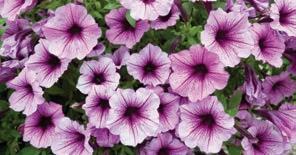



AHS DAYLILY DISPLAY GARDEN
Open for regular hours
July 3 through August 4
Wednesday thru Sunday, 10am to 5pm or any other time by appointment
Closed Monday & Tuesday
Group tours are welcome
Gift certificates available for purchase on site, mail, or thru website 557 Sand Hill Rd Caledonia • 860.378.4742
QBDAYLILYGARDENS.COM
Clip this ad for a $5 discount.
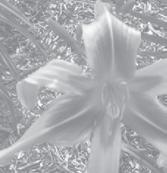


PURE, NATURAL, LOCAL HONEY. Award-winning small scale apiary by Lake Ontario. SeawayTrailHoney.com 585-820-6619
PAPERBARK MAPLE. World’s most beautiful Maple. 4 feet to 6 feet. Specimens to 9 feet. Fifteen varieties deer-proof ferns. Hardy Mimosa, Dawn Redwood, Paulonia trees. European Ginger, Hostas, Mexican Sunflower. Call Howard Ecker 585671-2397 for appointment. Grower for 68 years in Webster.
DAYLILIES. Daylilies are outstanding, carefree perennials. We grow and sell over 225 top-rated award-winning varieties in many colors and sizes in our Rochester garden. We are also an official national daylily society display garden. We welcome visitors to see the flowers in bloom from June to September. Call 585/461-3317.




September 14 September 15 1-5
Bristol’s Garden Center 7454 NY-96, Victor
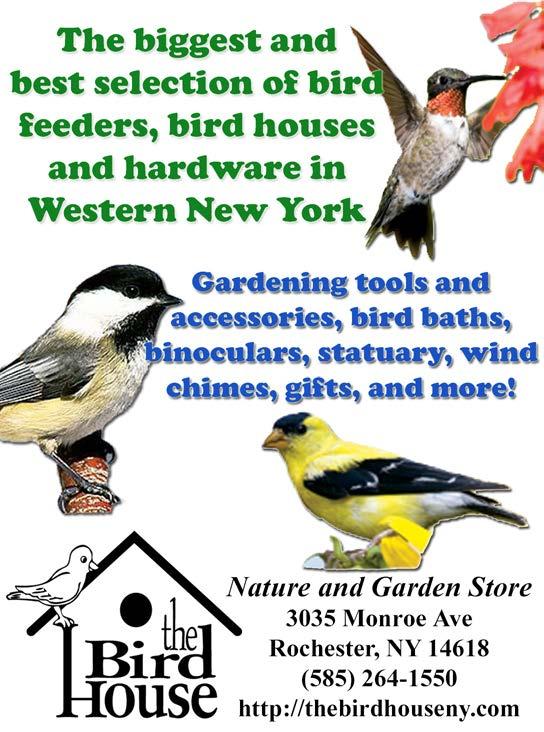






Rain chains are all the rage, and for good reason. These decorative metal chains redirect water from your gutter to the ground instead of your traditional downspout. There are lots of options online and in stores, but you can make a simple one at home.
MATERIALS
Metal shower curtain rings
Assorted glass beads (larger size with wide holes)
28-gauge galvanized steel “hanging” wire
OR large stainless steel paperclips
Rain chain gutter adapter (available online and in many garden centers)
TOOLS Pliers
Come visit us at COTTAGE GARDENS and see all the color and forms of our daylilies—more than 4100 cultivars
4540 East Shelby Road Medina, New York 14103 RETAIL & AHS DISPLAY GARDEN
Open the month of July closed on Mondays and the 4th of July 10am–5pm or by appointment

email: cglilies@rochester.rr.com
Phone 585-798-5441
Web: http://www.daylily.net/gardens/cottagegardens
We welcome garden tours • Gift Certificates available
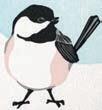
noreen riordan
native plant design for the home garden
isa certified arborist ny-1164 a nysdec certified nursery and landscape professional
birdsonglandscapedesign.com (585) 402-4061
birdsonglandscapedesign@gmail.com
1. Measure the distance from the ground to the gutter so you know how long your chain should be.
2. Install the gutter adapter according to package directions.
3. Clip several lengths of wire (3 to 4 inches is a good place to start, but you can cut longer pieces if desired) using the wire snippers on your pliers. Thread the pieces of wire with several beads and use the pliers to create a curl of wire at each end. Alternately, you can use paper clips. Open the clip with the pliers and follow the same steps.
4. Attach the pieces of wire and beads to the shower curtain rings in your desired pattern until the rain chain is the length you need.
5. Hang from your gutter adapter and enjoy!
Christine Green is the managing editor of Upstate Gardeners' Journal.
See: 8 acres of gardens
Over 2000 hosta varieties
Rare trees & shrubs • Unusual perennials
Restroom & picnic tables
*Hundreds of hosta and other plants for sale Rt. 20, Sheridan, NY Open most days 11AM–6 PM Sundays 2 PM–6 PM 716 792-7581 or 969-1688
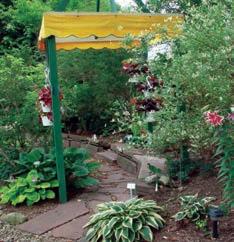
E-Mail: rblydell@gmail.com Web: www.eaglebaygardens.net/index.html
